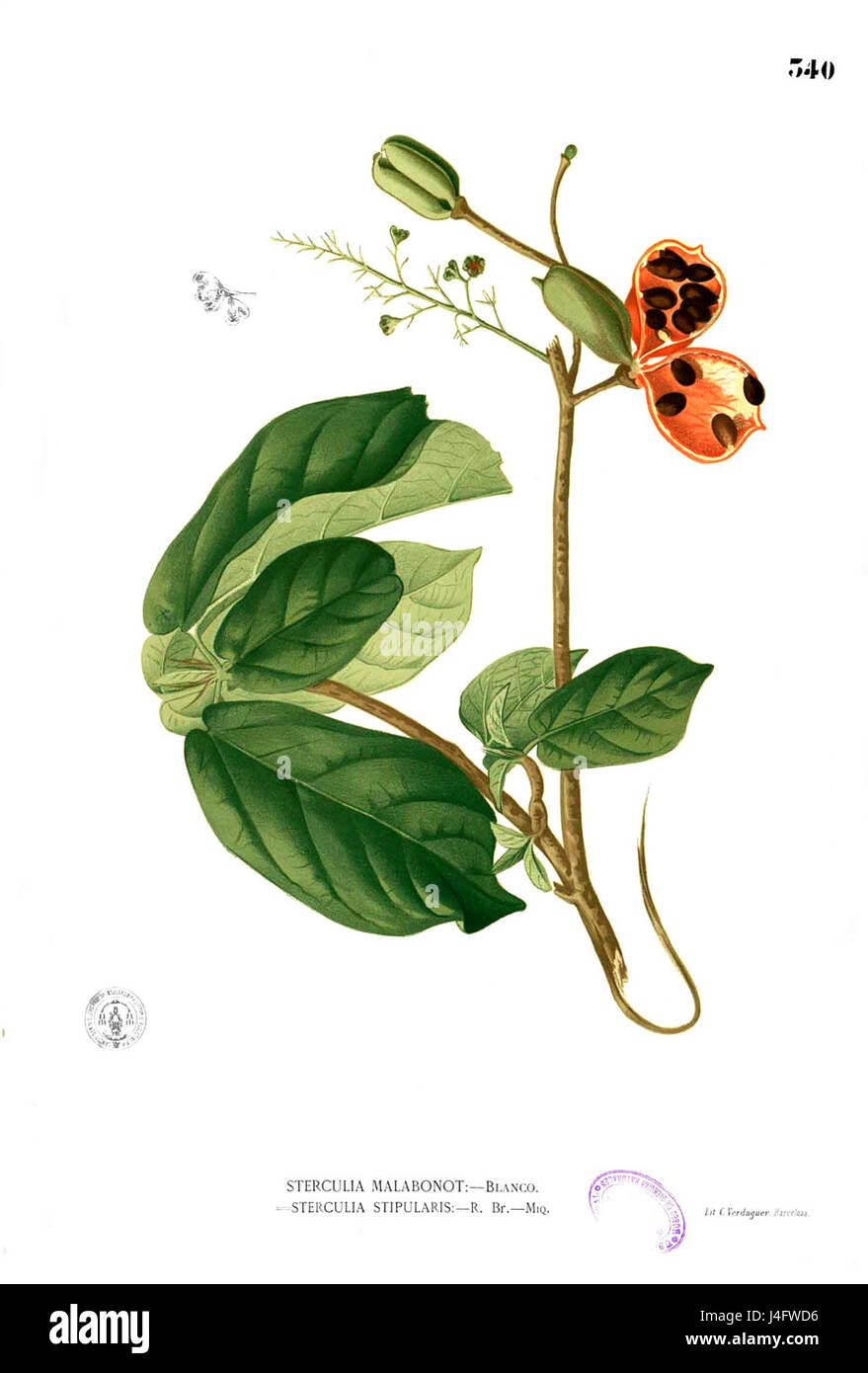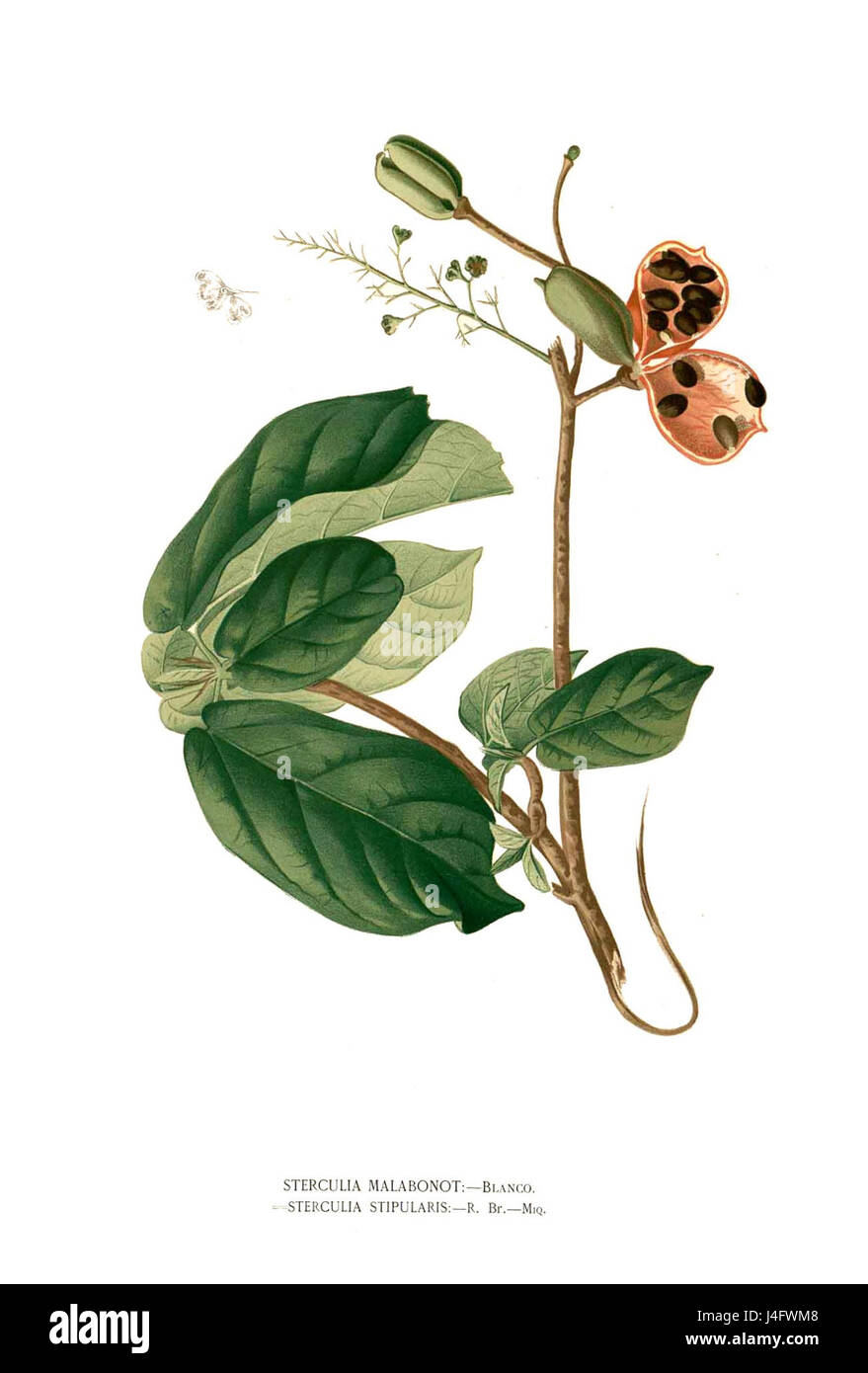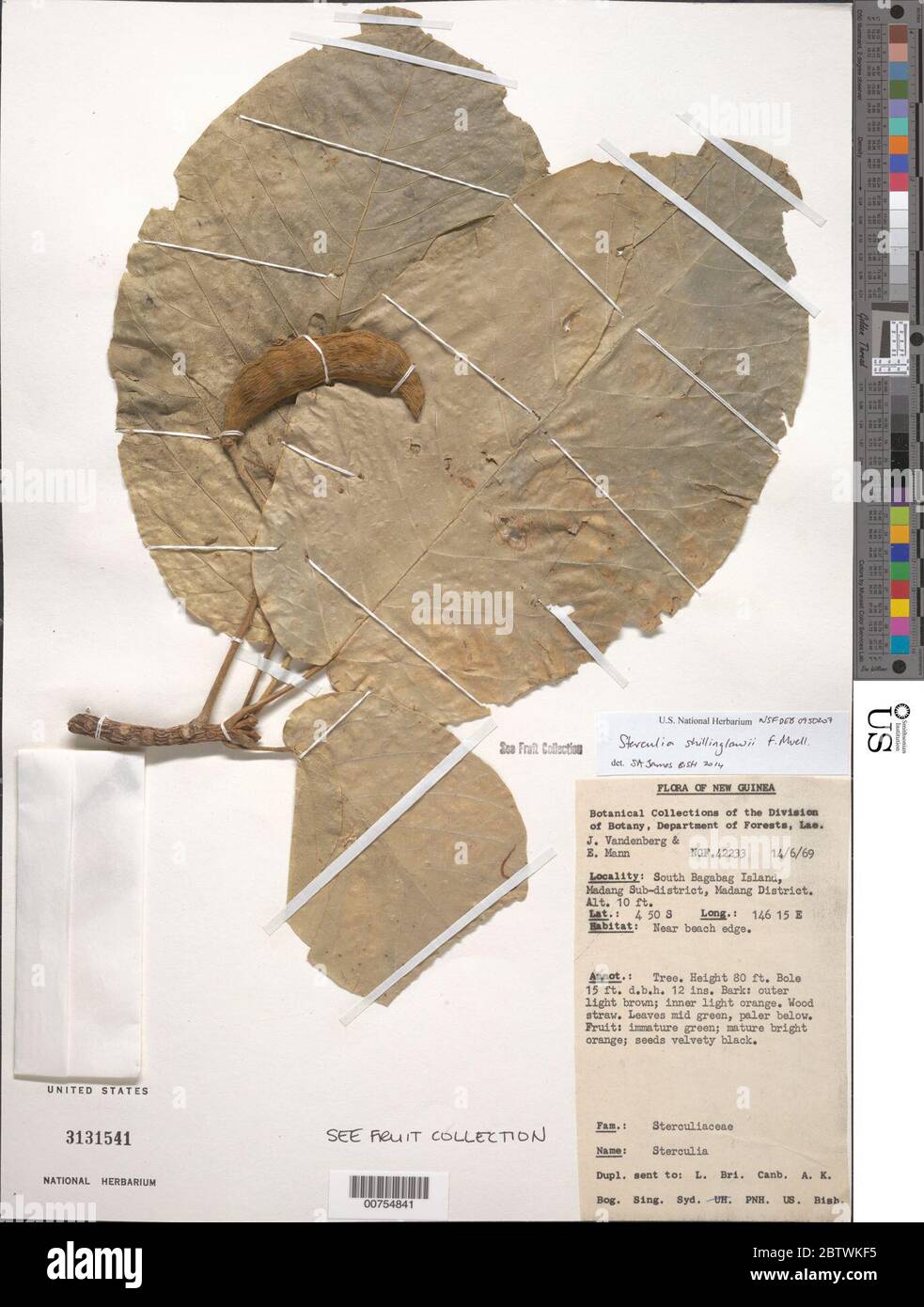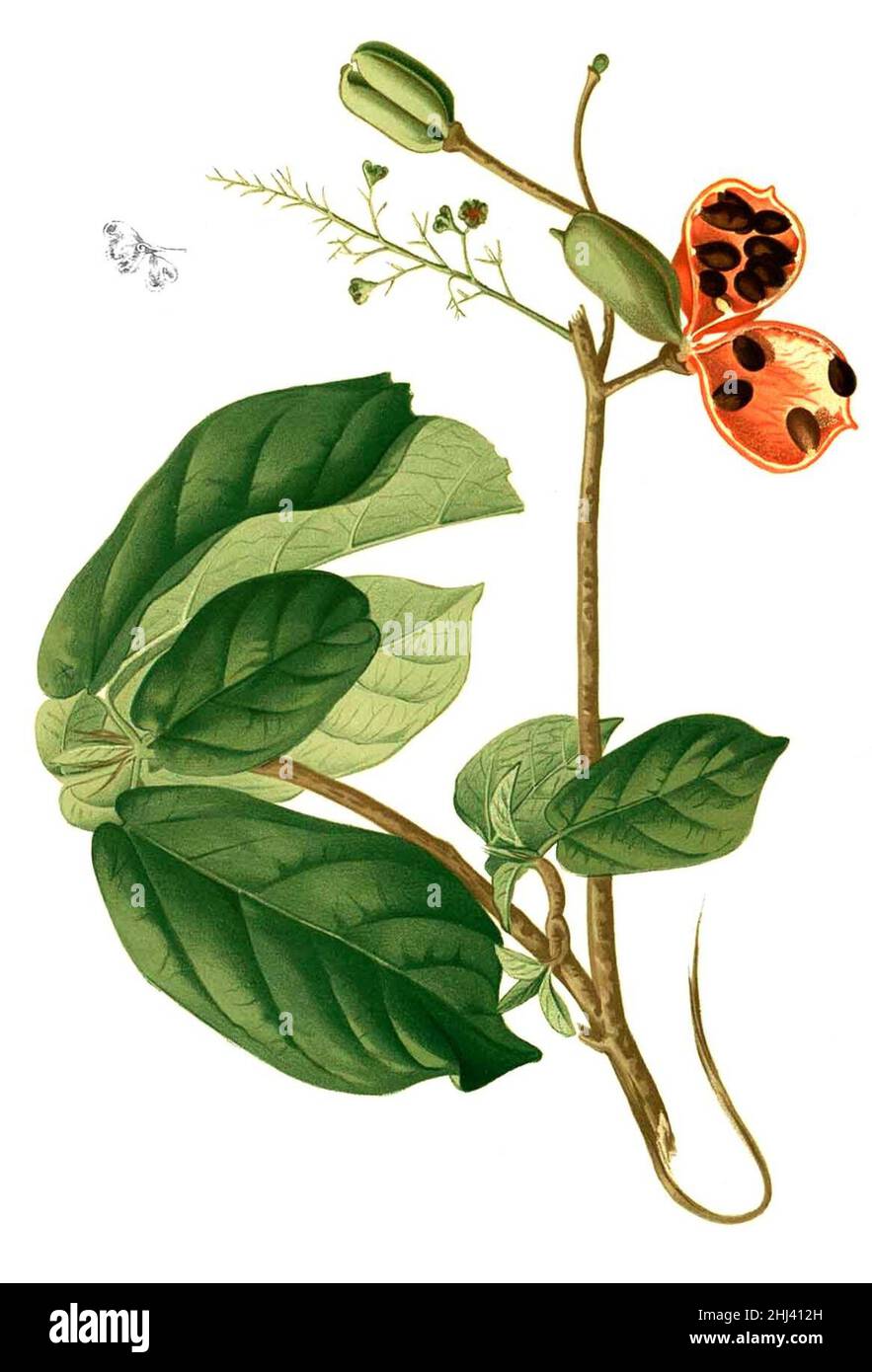Quick filters:
Sterculia sp Stock Photos and Images
 Overripe 'Popoko' fruit on the forest floor, Sterculia (Sterculia sp) eaten by a lot of forest animals and water from the boiled bark is used as a cold remedy by local tribes people, Bai Hokou, Dzanga-Ndoki National Park, Central African Republic. Stock Photohttps://www.alamy.com/image-license-details/?v=1https://www.alamy.com/overripe-popoko-fruit-on-the-forest-floor-sterculia-sterculia-sp-eaten-by-a-lot-of-forest-animals-and-water-from-the-boiled-bark-is-used-as-a-cold-remedy-by-local-tribes-people-bai-hokou-dzanga-ndoki-national-park-central-african-republic-image262938884.html
Overripe 'Popoko' fruit on the forest floor, Sterculia (Sterculia sp) eaten by a lot of forest animals and water from the boiled bark is used as a cold remedy by local tribes people, Bai Hokou, Dzanga-Ndoki National Park, Central African Republic. Stock Photohttps://www.alamy.com/image-license-details/?v=1https://www.alamy.com/overripe-popoko-fruit-on-the-forest-floor-sterculia-sterculia-sp-eaten-by-a-lot-of-forest-animals-and-water-from-the-boiled-bark-is-used-as-a-cold-remedy-by-local-tribes-people-bai-hokou-dzanga-ndoki-national-park-central-african-republic-image262938884.htmlRMW7NW6C–Overripe 'Popoko' fruit on the forest floor, Sterculia (Sterculia sp) eaten by a lot of forest animals and water from the boiled bark is used as a cold remedy by local tribes people, Bai Hokou, Dzanga-Ndoki National Park, Central African Republic.
 Sterculia sp Blanco2.448 Stock Photohttps://www.alamy.com/image-license-details/?v=1https://www.alamy.com/stock-photo-sterculia-sp-blanco2448-140506547.html
Sterculia sp Blanco2.448 Stock Photohttps://www.alamy.com/image-license-details/?v=1https://www.alamy.com/stock-photo-sterculia-sp-blanco2448-140506547.htmlRMJ4GHEY–Sterculia sp Blanco2.448
 Ripe 'Popoko' fruit on the forest floor, Sterculia (Sterculia sp) eaten by a lot of forest animals and water from the boiled bark is used as a cold remedy by local tribes people, Bai Hokou, Dzanga-Ndoki National Park, Central African Republic. Stock Photohttps://www.alamy.com/image-license-details/?v=1https://www.alamy.com/ripe-popoko-fruit-on-the-forest-floor-sterculia-sterculia-sp-eaten-by-a-lot-of-forest-animals-and-water-from-the-boiled-bark-is-used-as-a-cold-remedy-by-local-tribes-people-bai-hokou-dzanga-ndoki-national-park-central-african-republic-image262938925.html
Ripe 'Popoko' fruit on the forest floor, Sterculia (Sterculia sp) eaten by a lot of forest animals and water from the boiled bark is used as a cold remedy by local tribes people, Bai Hokou, Dzanga-Ndoki National Park, Central African Republic. Stock Photohttps://www.alamy.com/image-license-details/?v=1https://www.alamy.com/ripe-popoko-fruit-on-the-forest-floor-sterculia-sterculia-sp-eaten-by-a-lot-of-forest-animals-and-water-from-the-boiled-bark-is-used-as-a-cold-remedy-by-local-tribes-people-bai-hokou-dzanga-ndoki-national-park-central-african-republic-image262938925.htmlRMW7NW7W–Ripe 'Popoko' fruit on the forest floor, Sterculia (Sterculia sp) eaten by a lot of forest animals and water from the boiled bark is used as a cold remedy by local tribes people, Bai Hokou, Dzanga-Ndoki National Park, Central African Republic.
 Tropical Chestnut flower, Sterculia sp, with black ripe fruit capsules with seeds, Rainforest Discovery Centre, Sepilok National Park, Sandakan, Sabah Stock Photohttps://www.alamy.com/image-license-details/?v=1https://www.alamy.com/tropical-chestnut-flower-sterculia-sp-with-black-ripe-fruit-capsules-with-seeds-rainforest-discovery-centre-sepilok-national-park-sandakan-sabah-image329830512.html
Tropical Chestnut flower, Sterculia sp, with black ripe fruit capsules with seeds, Rainforest Discovery Centre, Sepilok National Park, Sandakan, Sabah Stock Photohttps://www.alamy.com/image-license-details/?v=1https://www.alamy.com/tropical-chestnut-flower-sterculia-sp-with-black-ripe-fruit-capsules-with-seeds-rainforest-discovery-centre-sepilok-national-park-sandakan-sabah-image329830512.htmlRF2A4H254–Tropical Chestnut flower, Sterculia sp, with black ripe fruit capsules with seeds, Rainforest Discovery Centre, Sepilok National Park, Sandakan, Sabah
 Sterculia sp. Stock Photohttps://www.alamy.com/image-license-details/?v=1https://www.alamy.com/sterculia-sp-image359502261.html
Sterculia sp. Stock Photohttps://www.alamy.com/image-license-details/?v=1https://www.alamy.com/sterculia-sp-image359502261.htmlRM2BTTMPD–Sterculia sp.
 Tropical Chestnut flower, Sterculia sp, with black ripe fruit capsules with seeds, Rainforest Discovery Centre, Sepilok National Park, Sandakan, Sabah Stock Photohttps://www.alamy.com/image-license-details/?v=1https://www.alamy.com/tropical-chestnut-flower-sterculia-sp-with-black-ripe-fruit-capsules-with-seeds-rainforest-discovery-centre-sepilok-national-park-sandakan-sabah-image329830902.html
Tropical Chestnut flower, Sterculia sp, with black ripe fruit capsules with seeds, Rainforest Discovery Centre, Sepilok National Park, Sandakan, Sabah Stock Photohttps://www.alamy.com/image-license-details/?v=1https://www.alamy.com/tropical-chestnut-flower-sterculia-sp-with-black-ripe-fruit-capsules-with-seeds-rainforest-discovery-centre-sepilok-national-park-sandakan-sabah-image329830902.htmlRF2A4H2K2–Tropical Chestnut flower, Sterculia sp, with black ripe fruit capsules with seeds, Rainforest Discovery Centre, Sepilok National Park, Sandakan, Sabah
 Sterculia sp Blanco clean. Stock Photohttps://www.alamy.com/image-license-details/?v=1https://www.alamy.com/sterculia-sp-blanco-clean-image458622068.html
Sterculia sp Blanco clean. Stock Photohttps://www.alamy.com/image-license-details/?v=1https://www.alamy.com/sterculia-sp-blanco-clean-image458622068.htmlRM2HJ413G–Sterculia sp Blanco clean.
 Organography of plants, especially of the archegoniatae and spermaphyta . Fig. 266. Leucoden-dron argenteum. Seed-ling plant. Ci, cotyledon,the other cotyledon hasbeen removed at line Cn.The bud of the stem isseen in a depression ofthe base of the cotyledon.IVh, root-collar, limit be-tween hypocotyl and root. COTYLEDONS OF DICOTYLEDONES 403. Fig. 267. Sterculia sp. in Buitenzorg Garden. 1, portionof embryo and endosperm in longitudinal section ; Co, cotyle-don ; St, stalk of cotyledon ; E, the endosperm, shaded inthefigure, i, the same in transverse section. Lettering the same. foliage-leaves. Stock Photohttps://www.alamy.com/image-license-details/?v=1https://www.alamy.com/organography-of-plants-especially-of-the-archegoniatae-and-spermaphyta-fig-266-leucoden-dron-argenteum-seed-ling-plant-ci-cotyledonthe-other-cotyledon-hasbeen-removed-at-line-cnthe-bud-of-the-stem-isseen-in-a-depression-ofthe-base-of-the-cotyledonivh-root-collar-limit-be-tween-hypocotyl-and-root-cotyledons-of-dicotyledones-403-fig-267-sterculia-sp-in-buitenzorg-garden-1-portionof-embryo-and-endosperm-in-longitudinal-section-co-cotyle-don-st-stalk-of-cotyledon-e-the-endosperm-shaded-inthefigure-i-the-same-in-transverse-section-lettering-the-same-foliage-leaves-image340153029.html
Organography of plants, especially of the archegoniatae and spermaphyta . Fig. 266. Leucoden-dron argenteum. Seed-ling plant. Ci, cotyledon,the other cotyledon hasbeen removed at line Cn.The bud of the stem isseen in a depression ofthe base of the cotyledon.IVh, root-collar, limit be-tween hypocotyl and root. COTYLEDONS OF DICOTYLEDONES 403. Fig. 267. Sterculia sp. in Buitenzorg Garden. 1, portionof embryo and endosperm in longitudinal section ; Co, cotyle-don ; St, stalk of cotyledon ; E, the endosperm, shaded inthefigure, i, the same in transverse section. Lettering the same. foliage-leaves. Stock Photohttps://www.alamy.com/image-license-details/?v=1https://www.alamy.com/organography-of-plants-especially-of-the-archegoniatae-and-spermaphyta-fig-266-leucoden-dron-argenteum-seed-ling-plant-ci-cotyledonthe-other-cotyledon-hasbeen-removed-at-line-cnthe-bud-of-the-stem-isseen-in-a-depression-ofthe-base-of-the-cotyledonivh-root-collar-limit-be-tween-hypocotyl-and-root-cotyledons-of-dicotyledones-403-fig-267-sterculia-sp-in-buitenzorg-garden-1-portionof-embryo-and-endosperm-in-longitudinal-section-co-cotyle-don-st-stalk-of-cotyledon-e-the-endosperm-shaded-inthefigure-i-the-same-in-transverse-section-lettering-the-same-foliage-leaves-image340153029.htmlRM2ANB8JD–Organography of plants, especially of the archegoniatae and spermaphyta . Fig. 266. Leucoden-dron argenteum. Seed-ling plant. Ci, cotyledon,the other cotyledon hasbeen removed at line Cn.The bud of the stem isseen in a depression ofthe base of the cotyledon.IVh, root-collar, limit be-tween hypocotyl and root. COTYLEDONS OF DICOTYLEDONES 403. Fig. 267. Sterculia sp. in Buitenzorg Garden. 1, portionof embryo and endosperm in longitudinal section ; Co, cotyle-don ; St, stalk of cotyledon ; E, the endosperm, shaded inthefigure, i, the same in transverse section. Lettering the same. foliage-leaves.
 Sterculia sp Blanco2.340 Stock Photohttps://www.alamy.com/image-license-details/?v=1https://www.alamy.com/stock-photo-sterculia-sp-blanco2340-140490818.html
Sterculia sp Blanco2.340 Stock Photohttps://www.alamy.com/image-license-details/?v=1https://www.alamy.com/stock-photo-sterculia-sp-blanco2340-140490818.htmlRMJ4FWD6–Sterculia sp Blanco2.340
 Sterculia sp. Stock Photohttps://www.alamy.com/image-license-details/?v=1https://www.alamy.com/sterculia-sp-image359464194.html
Sterculia sp. Stock Photohttps://www.alamy.com/image-license-details/?v=1https://www.alamy.com/sterculia-sp-image359464194.htmlRM2BTR06X–Sterculia sp.
 Tropical Chestnut flower, Sterculia sp, with black ripe fruit capsules with seeds, Rainforest Discovery Centre, Sepilok National Park, Sandakan, Sabah Stock Photohttps://www.alamy.com/image-license-details/?v=1https://www.alamy.com/tropical-chestnut-flower-sterculia-sp-with-black-ripe-fruit-capsules-with-seeds-rainforest-discovery-centre-sepilok-national-park-sandakan-sabah-image329830896.html
Tropical Chestnut flower, Sterculia sp, with black ripe fruit capsules with seeds, Rainforest Discovery Centre, Sepilok National Park, Sandakan, Sabah Stock Photohttps://www.alamy.com/image-license-details/?v=1https://www.alamy.com/tropical-chestnut-flower-sterculia-sp-with-black-ripe-fruit-capsules-with-seeds-rainforest-discovery-centre-sepilok-national-park-sandakan-sabah-image329830896.htmlRF2A4H2JT–Tropical Chestnut flower, Sterculia sp, with black ripe fruit capsules with seeds, Rainforest Discovery Centre, Sepilok National Park, Sandakan, Sabah
 Sterculia sp Blanco2.340. Stock Photohttps://www.alamy.com/image-license-details/?v=1https://www.alamy.com/sterculia-sp-blanco2340-image458622054.html
Sterculia sp Blanco2.340. Stock Photohttps://www.alamy.com/image-license-details/?v=1https://www.alamy.com/sterculia-sp-blanco2340-image458622054.htmlRM2HJ4132–Sterculia sp Blanco2.340.
 Madagascar : les bois de la forêt d'Analamazaotra . II. Sterculia sp.(SltTciiIiacées). IMP. CATAI.A FRÈRES, PARIS. A. CHALLAMEL. ÉDITEUR. TILIACEES La famille des Tiliacées comprend un grand nombre darbres et darbustes et elle vientse placer au voisinage des Sterculiacées, Malvacées et Elaocarpacées. Tout le monde connaît le Tilleul de nos pas européens dont le nom, Tilia, a servi deracine à celui de la famille. Nous possédons dans nos pays plusieurs espèces du genre Tilia dont les bois sont assezestimés, bien que rentrant dans la catégorie des bois blancs. Les genres Pentace, Berrya et Grewi Stock Photohttps://www.alamy.com/image-license-details/?v=1https://www.alamy.com/madagascar-les-bois-de-la-fort-danalamazaotra-ii-sterculia-spslttciiiiaces-imp-cataia-frres-paris-a-challamel-diteur-tiliacees-la-famille-des-tiliaces-comprend-un-grand-nombre-darbres-et-darbustes-et-elle-vientse-placer-au-voisinage-des-sterculiaces-malvaces-et-elaocarpaces-tout-le-monde-connat-le-tilleul-de-nos-pas-europens-dont-le-nom-tilia-a-servi-deracine-celui-de-la-famille-nous-possdons-dans-nos-pays-plusieurs-espces-du-genre-tilia-dont-les-bois-sont-assezestims-bien-que-rentrant-dans-la-catgorie-des-bois-blancs-les-genres-pentace-berrya-et-grewi-image342644480.html
Madagascar : les bois de la forêt d'Analamazaotra . II. Sterculia sp.(SltTciiIiacées). IMP. CATAI.A FRÈRES, PARIS. A. CHALLAMEL. ÉDITEUR. TILIACEES La famille des Tiliacées comprend un grand nombre darbres et darbustes et elle vientse placer au voisinage des Sterculiacées, Malvacées et Elaocarpacées. Tout le monde connaît le Tilleul de nos pas européens dont le nom, Tilia, a servi deracine à celui de la famille. Nous possédons dans nos pays plusieurs espèces du genre Tilia dont les bois sont assezestimés, bien que rentrant dans la catégorie des bois blancs. Les genres Pentace, Berrya et Grewi Stock Photohttps://www.alamy.com/image-license-details/?v=1https://www.alamy.com/madagascar-les-bois-de-la-fort-danalamazaotra-ii-sterculia-spslttciiiiaces-imp-cataia-frres-paris-a-challamel-diteur-tiliacees-la-famille-des-tiliaces-comprend-un-grand-nombre-darbres-et-darbustes-et-elle-vientse-placer-au-voisinage-des-sterculiaces-malvaces-et-elaocarpaces-tout-le-monde-connat-le-tilleul-de-nos-pas-europens-dont-le-nom-tilia-a-servi-deracine-celui-de-la-famille-nous-possdons-dans-nos-pays-plusieurs-espces-du-genre-tilia-dont-les-bois-sont-assezestims-bien-que-rentrant-dans-la-catgorie-des-bois-blancs-les-genres-pentace-berrya-et-grewi-image342644480.htmlRM2AWCPET–Madagascar : les bois de la forêt d'Analamazaotra . II. Sterculia sp.(SltTciiIiacées). IMP. CATAI.A FRÈRES, PARIS. A. CHALLAMEL. ÉDITEUR. TILIACEES La famille des Tiliacées comprend un grand nombre darbres et darbustes et elle vientse placer au voisinage des Sterculiacées, Malvacées et Elaocarpacées. Tout le monde connaît le Tilleul de nos pas européens dont le nom, Tilia, a servi deracine à celui de la famille. Nous possédons dans nos pays plusieurs espèces du genre Tilia dont les bois sont assezestimés, bien que rentrant dans la catégorie des bois blancs. Les genres Pentace, Berrya et Grewi
 Sterculia sp Blanco clean Stock Photohttps://www.alamy.com/image-license-details/?v=1https://www.alamy.com/stock-photo-sterculia-sp-blanco-clean-140491016.html
Sterculia sp Blanco clean Stock Photohttps://www.alamy.com/image-license-details/?v=1https://www.alamy.com/stock-photo-sterculia-sp-blanco-clean-140491016.htmlRMJ4FWM8–Sterculia sp Blanco clean
 Sterculia sp. Stock Photohttps://www.alamy.com/image-license-details/?v=1https://www.alamy.com/sterculia-sp-image359523225.html
Sterculia sp. Stock Photohttps://www.alamy.com/image-license-details/?v=1https://www.alamy.com/sterculia-sp-image359523225.htmlRM2BTWKF5–Sterculia sp.
 Sterculia sp Blanco2.448. Stock Photohttps://www.alamy.com/image-license-details/?v=1https://www.alamy.com/sterculia-sp-blanco2448-image458622052.html
Sterculia sp Blanco2.448. Stock Photohttps://www.alamy.com/image-license-details/?v=1https://www.alamy.com/sterculia-sp-blanco2448-image458622052.htmlRM2HJ4130–Sterculia sp Blanco2.448.
![A description of some Chinese vegetable food materials and their nutritive and economic value . eidentified. The Chinese drug stores also furnish some curious objects of a veg-etable nature. Among these were identified, chiefly through the reportof Hanbury ^ on the Chinese materia medica, the fruit stalks of Hoveniadulcis, the seeds of Torreya nuci/era, Quisqualis indica, Momordica{Muricia) cochinchinensis, Terminalia chehula, Sterculia platani/oliajIpomaa hederacea, Chalmougra sp., Melia sp., and the fruits of aspecies of Gardenia. Imp. Univ. Col. Agr. [Tokyo] Bui., Vol. 2 (1894), p. 103. 2 U Stock Photo A description of some Chinese vegetable food materials and their nutritive and economic value . eidentified. The Chinese drug stores also furnish some curious objects of a veg-etable nature. Among these were identified, chiefly through the reportof Hanbury ^ on the Chinese materia medica, the fruit stalks of Hoveniadulcis, the seeds of Torreya nuci/era, Quisqualis indica, Momordica{Muricia) cochinchinensis, Terminalia chehula, Sterculia platani/oliajIpomaa hederacea, Chalmougra sp., Melia sp., and the fruits of aspecies of Gardenia. Imp. Univ. Col. Agr. [Tokyo] Bui., Vol. 2 (1894), p. 103. 2 U Stock Photo](https://c8.alamy.com/comp/2AM1KNP/a-description-of-some-chinese-vegetable-food-materials-and-their-nutritive-and-economic-value-eidentified-the-chinese-drug-stores-also-furnish-some-curious-objects-of-a-veg-etable-nature-among-these-were-identified-chiefly-through-the-reportof-hanbury-on-the-chinese-materia-medica-the-fruit-stalks-of-hoveniadulcis-the-seeds-of-torreya-nuciera-quisqualis-indica-momordicamuricia-cochinchinensis-terminalia-chehula-sterculia-platanioliajipomaa-hederacea-chalmougra-sp-melia-sp-and-the-fruits-of-aspecies-of-gardenia-imp-univ-col-agr-tokyo-bui-vol-2-1894-p-103-2-u-2AM1KNP.jpg) A description of some Chinese vegetable food materials and their nutritive and economic value . eidentified. The Chinese drug stores also furnish some curious objects of a veg-etable nature. Among these were identified, chiefly through the reportof Hanbury ^ on the Chinese materia medica, the fruit stalks of Hoveniadulcis, the seeds of Torreya nuci/era, Quisqualis indica, Momordica{Muricia) cochinchinensis, Terminalia chehula, Sterculia platani/oliajIpomaa hederacea, Chalmougra sp., Melia sp., and the fruits of aspecies of Gardenia. Imp. Univ. Col. Agr. [Tokyo] Bui., Vol. 2 (1894), p. 103. 2 U Stock Photohttps://www.alamy.com/image-license-details/?v=1https://www.alamy.com/a-description-of-some-chinese-vegetable-food-materials-and-their-nutritive-and-economic-value-eidentified-the-chinese-drug-stores-also-furnish-some-curious-objects-of-a-veg-etable-nature-among-these-were-identified-chiefly-through-the-reportof-hanbury-on-the-chinese-materia-medica-the-fruit-stalks-of-hoveniadulcis-the-seeds-of-torreya-nuciera-quisqualis-indica-momordicamuricia-cochinchinensis-terminalia-chehula-sterculia-platanioliajipomaa-hederacea-chalmougra-sp-melia-sp-and-the-fruits-of-aspecies-of-gardenia-imp-univ-col-agr-tokyo-bui-vol-2-1894-p-103-2-u-image339327570.html
A description of some Chinese vegetable food materials and their nutritive and economic value . eidentified. The Chinese drug stores also furnish some curious objects of a veg-etable nature. Among these were identified, chiefly through the reportof Hanbury ^ on the Chinese materia medica, the fruit stalks of Hoveniadulcis, the seeds of Torreya nuci/era, Quisqualis indica, Momordica{Muricia) cochinchinensis, Terminalia chehula, Sterculia platani/oliajIpomaa hederacea, Chalmougra sp., Melia sp., and the fruits of aspecies of Gardenia. Imp. Univ. Col. Agr. [Tokyo] Bui., Vol. 2 (1894), p. 103. 2 U Stock Photohttps://www.alamy.com/image-license-details/?v=1https://www.alamy.com/a-description-of-some-chinese-vegetable-food-materials-and-their-nutritive-and-economic-value-eidentified-the-chinese-drug-stores-also-furnish-some-curious-objects-of-a-veg-etable-nature-among-these-were-identified-chiefly-through-the-reportof-hanbury-on-the-chinese-materia-medica-the-fruit-stalks-of-hoveniadulcis-the-seeds-of-torreya-nuciera-quisqualis-indica-momordicamuricia-cochinchinensis-terminalia-chehula-sterculia-platanioliajipomaa-hederacea-chalmougra-sp-melia-sp-and-the-fruits-of-aspecies-of-gardenia-imp-univ-col-agr-tokyo-bui-vol-2-1894-p-103-2-u-image339327570.htmlRM2AM1KNP–A description of some Chinese vegetable food materials and their nutritive and economic value . eidentified. The Chinese drug stores also furnish some curious objects of a veg-etable nature. Among these were identified, chiefly through the reportof Hanbury ^ on the Chinese materia medica, the fruit stalks of Hoveniadulcis, the seeds of Torreya nuci/era, Quisqualis indica, Momordica{Muricia) cochinchinensis, Terminalia chehula, Sterculia platani/oliajIpomaa hederacea, Chalmougra sp., Melia sp., and the fruits of aspecies of Gardenia. Imp. Univ. Col. Agr. [Tokyo] Bui., Vol. 2 (1894), p. 103. 2 U
 Sterculia sp Blanco2.448 cropped Stock Photohttps://www.alamy.com/image-license-details/?v=1https://www.alamy.com/stock-photo-sterculia-sp-blanco2448-cropped-140490700.html
Sterculia sp Blanco2.448 cropped Stock Photohttps://www.alamy.com/image-license-details/?v=1https://www.alamy.com/stock-photo-sterculia-sp-blanco2448-cropped-140490700.htmlRMJ4FW90–Sterculia sp Blanco2.448 cropped
 Sterculia sp. Stock Photohttps://www.alamy.com/image-license-details/?v=1https://www.alamy.com/sterculia-sp-image359464193.html
Sterculia sp. Stock Photohttps://www.alamy.com/image-license-details/?v=1https://www.alamy.com/sterculia-sp-image359464193.htmlRM2BTR06W–Sterculia sp.
 Sterculia sp Blanco2.340-cropped. Stock Photohttps://www.alamy.com/image-license-details/?v=1https://www.alamy.com/sterculia-sp-blanco2340-cropped-image458622041.html
Sterculia sp Blanco2.340-cropped. Stock Photohttps://www.alamy.com/image-license-details/?v=1https://www.alamy.com/sterculia-sp-blanco2340-cropped-image458622041.htmlRM2HJ412H–Sterculia sp Blanco2.340-cropped.
 Sterculia sp Blanco2.340 cropped Stock Photohttps://www.alamy.com/image-license-details/?v=1https://www.alamy.com/stock-photo-sterculia-sp-blanco2340-cropped-140510158.html
Sterculia sp Blanco2.340 cropped Stock Photohttps://www.alamy.com/image-license-details/?v=1https://www.alamy.com/stock-photo-sterculia-sp-blanco2340-cropped-140510158.htmlRMJ4GP3X–Sterculia sp Blanco2.340 cropped
 Sterculia sp. Stock Photohttps://www.alamy.com/image-license-details/?v=1https://www.alamy.com/sterculia-sp-image359502248.html
Sterculia sp. Stock Photohttps://www.alamy.com/image-license-details/?v=1https://www.alamy.com/sterculia-sp-image359502248.htmlRM2BTTMP0–Sterculia sp.
 Sterculia sp Blanco2.448-cropped. Stock Photohttps://www.alamy.com/image-license-details/?v=1https://www.alamy.com/sterculia-sp-blanco2448-cropped-image458622035.html
Sterculia sp Blanco2.448-cropped. Stock Photohttps://www.alamy.com/image-license-details/?v=1https://www.alamy.com/sterculia-sp-blanco2448-cropped-image458622035.htmlRM2HJ412B–Sterculia sp Blanco2.448-cropped.
 Sterculia sp. Stock Photohttps://www.alamy.com/image-license-details/?v=1https://www.alamy.com/sterculia-sp-image359502268.html
Sterculia sp. Stock Photohttps://www.alamy.com/image-license-details/?v=1https://www.alamy.com/sterculia-sp-image359502268.htmlRM2BTTMPM–Sterculia sp.
 Sterculia sp. Stock Photohttps://www.alamy.com/image-license-details/?v=1https://www.alamy.com/sterculia-sp-image359502263.html
Sterculia sp. Stock Photohttps://www.alamy.com/image-license-details/?v=1https://www.alamy.com/sterculia-sp-image359502263.htmlRM2BTTMPF–Sterculia sp.
 Sterculia sp. Stock Photohttps://www.alamy.com/image-license-details/?v=1https://www.alamy.com/sterculia-sp-image359502265.html
Sterculia sp. Stock Photohttps://www.alamy.com/image-license-details/?v=1https://www.alamy.com/sterculia-sp-image359502265.htmlRM2BTTMPH–Sterculia sp.
 Sterculia sp. Stock Photohttps://www.alamy.com/image-license-details/?v=1https://www.alamy.com/sterculia-sp-image359464205.html
Sterculia sp. Stock Photohttps://www.alamy.com/image-license-details/?v=1https://www.alamy.com/sterculia-sp-image359464205.htmlRM2BTR079–Sterculia sp.
 Sterculia sp. Stock Photohttps://www.alamy.com/image-license-details/?v=1https://www.alamy.com/sterculia-sp-image359464241.html
Sterculia sp. Stock Photohttps://www.alamy.com/image-license-details/?v=1https://www.alamy.com/sterculia-sp-image359464241.htmlRM2BTR08H–Sterculia sp.
 Sterculia sp Sterculia sp. Stock Photohttps://www.alamy.com/image-license-details/?v=1https://www.alamy.com/sterculia-sp-sterculia-sp-image360403122.html
Sterculia sp Sterculia sp. Stock Photohttps://www.alamy.com/image-license-details/?v=1https://www.alamy.com/sterculia-sp-sterculia-sp-image360403122.htmlRM2BX9NT2–Sterculia sp Sterculia sp.
 Sterculia sp Sterculia sp. Stock Photohttps://www.alamy.com/image-license-details/?v=1https://www.alamy.com/sterculia-sp-sterculia-sp-image362460703.html
Sterculia sp Sterculia sp. Stock Photohttps://www.alamy.com/image-license-details/?v=1https://www.alamy.com/sterculia-sp-sterculia-sp-image362460703.htmlRM2C1KE93–Sterculia sp Sterculia sp.
 Sterculia sp Sterculia sp. Stock Photohttps://www.alamy.com/image-license-details/?v=1https://www.alamy.com/sterculia-sp-sterculia-sp-image362306054.html
Sterculia sp Sterculia sp. Stock Photohttps://www.alamy.com/image-license-details/?v=1https://www.alamy.com/sterculia-sp-sterculia-sp-image362306054.htmlRM2C1CD1X–Sterculia sp Sterculia sp.
 Sterculia sp Sterculia sp. Stock Photohttps://www.alamy.com/image-license-details/?v=1https://www.alamy.com/sterculia-sp-sterculia-sp-image362423834.html
Sterculia sp Sterculia sp. Stock Photohttps://www.alamy.com/image-license-details/?v=1https://www.alamy.com/sterculia-sp-sterculia-sp-image362423834.htmlRM2C1HR8A–Sterculia sp Sterculia sp.
 Sterculia sp Sterculia sp. Stock Photohttps://www.alamy.com/image-license-details/?v=1https://www.alamy.com/sterculia-sp-sterculia-sp-image362305972.html
Sterculia sp Sterculia sp. Stock Photohttps://www.alamy.com/image-license-details/?v=1https://www.alamy.com/sterculia-sp-sterculia-sp-image362305972.htmlRM2C1CCY0–Sterculia sp Sterculia sp.

